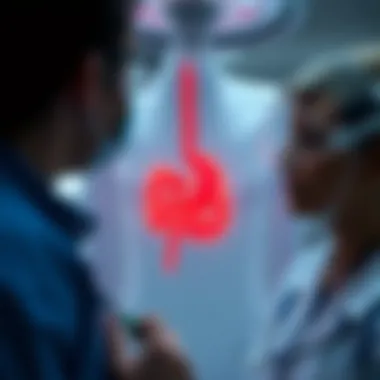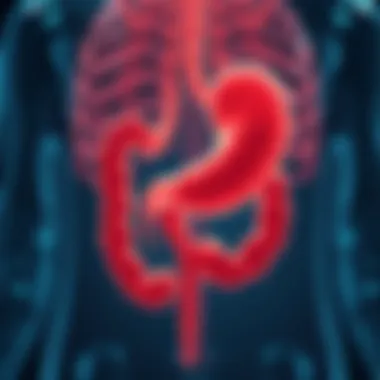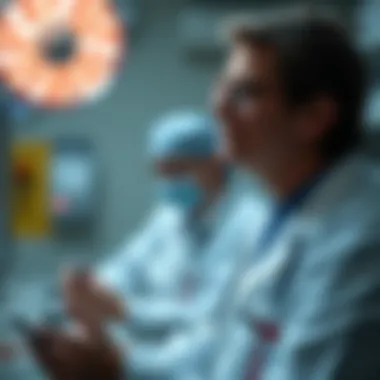Gastric Cancer Prevention Strategies: A Comprehensive Overview


Intro
Gastric cancer, often shrouded in the shadows of more prevalent cancers, deserves a spotlight—especially considering its intricate relationship with our daily habits. As awareness of gastric cancer rises, understanding the preventive measures becomes crucial. This article delves into an array of strategies aimed at mitigating the risks associated with this condition. By examining dietary influences, lifestyle changes, and genetic components, we shed light on a multifaceted approach that empowers individuals to make informed choices regarding their health.
The strategies discussed are not merely theoretical; they stem from rigorous scientific research and community health initiatives. They aim to bridge the gap between understanding and implementation, helping readers translate knowledge into action. With a keen eye on the nuances of how various factors can intertwine to affect gastric cancer risk, we also consider the personal and environmental influences that play pivotal roles. Ultimately, this exploration seeks to enrich public health discussions and inspire proactive measures against gastric cancer.
Prelude to Gastric Cancer
Understanding gastric cancer is pivotal for both public health and individual well-being. This type of cancer arises from the lining of the stomach and remains one of the leading causes of cancer-related deaths worldwide. With its complex etiology involving genetic, environmental, and lifestyle factors, any serious discussion of gastric cancer necessitates a comprehensive overview—one that incorporates prevention strategies alongside awareness and education.
Gastric cancer's late presentation and often vague symptoms make early detection challenging, emphasizing the need for greater understanding. Thus, this section sets the stage for delving deeper into gastric cancer prevention strategies. Knowledge of the disease can lead to informed lifestyle choices, potentially reducing incidence rates and improving health outcomes.
Understanding Gastric Cancer
Gastric cancer, often referred to as stomach cancer, typically begins in the cells lining the stomach. The development of the cancer is intricately tied to dietary habits, infections, and genetic risk factors. For example, the bacterium Helicobacter pylori, found in many stomachs, plays a significant role in the disease's progression. Symptoms associated with gastric cancer, which may include abdominal pain, nausea, and weight loss, usually emerge at advanced stages, prompting a critical need for preventive measures and education.
It's crucial to be aware that not all stomach cancers are the same; variations exist that can affect prognosis and treatment options. By distinguishing between types like adenocarcinoma and gastrointestinal stromal tumors, one can glean insights into tailored prevention strategies, which can be significant for those at higher risk due to their genetics or lifestyle choices.
Prevalence and Global Impact
Globally, gastric cancer represents a substantial public health issue. According to the World Health Organization, it ranks as the fifth most common cancer worldwide and accounts for nearly 800,000 deaths annually. Regions such as East Asia, particularly Japan and Korea, experience notably higher rates, prompting increased vigilance and preventative strategies in these areas.
"Gastric cancer often flies under the radar, but its impact on society can't be overlooked. It's not just a health issue; it's a significant economic burden and deeply intertwines with social factors."
The socioeconomic gradient in gastric cancer incidence highlights disparities in healthcare access, awareness, and education. Lower-income populations may experience higher rates due to lack of resources for preventive healthcare, emphasizing the necessity for targeted public health initiatives.
Furthermore, as globalization intertwines food systems, dietary changes might affect gastric cancer trends worldwide, compounding the urgency for preventive strategies tailored to diverse populations. Understanding these global patterns not only sheds light on the disease's burden but also sets the groundwork for improving education, awareness, and care on a larger scale.
Risk Factors Associated with Gastric Cancer
Understanding the risk factors associated with gastric cancer is crucial. It leads to not just awareness but also proactive strategies for prevention. Different influences come into play, from environmental factors to genetic predispositions, making this a multifaceted topic. Identifying these factors can help individuals make informed choices that could significantly reduce their risk. Additionally, comprehending how these risk factors intertwine is vital for researchers and healthcare professionals in developing targeted prevention strategies.
Environmental Influences
Environmental factors are often the silent players in the game of cancer development, including gastric cancer. Pollution has been linked to a variety of health issues, with research suggesting that individuals living in urban areas may have a higher incidence of this type of cancer. Exposure to certain harmful chemicals, like pesticides and industrial solvents, could raise the stakes. Moreover, the levels of socioeconomic status and living conditions often dictate the quality of food and healthcare accessible to individuals, further shaping cancer risks.
Genetic Predispositions
Genetic factors are another piece of the puzzle. Certain gene mutations can heighten the likelihood of developing gastric cancer. For example, individuals with a family history of gastric cancer should exercise heightened vigilance, especially if there is a known genetic link in their lineage. The CD gene is one of the notable genes associated with hereditary diffuse gastric cancer. Individuals with mutations in this gene may face up to an 80% chance of developing the disease, thereby emphasizing the need for genetic counseling and screening.
Understanding these genetic predispositions, however, can empower patients. Knowledge of one’s genetic background can lead to proactive health measures. It can guide decisions about lifestyle changes, diet, and regular screenings, which significantly correlate with early detection.
Dietary Contributions
Diet serves as a double-edged sword in gastric cancer prevention. Research shows that a diet rich in fruits, vegetables, and whole grains can act as a protective barrier. These foods are laden with antioxidants and essential micronutrients that might lower risks. Conversely, the consumption of processed meats, excessive salt, and smoked foods can elevate one’s risk. These dietary habits introduce hazardous compounds into the body, increasing gastric acid production and the potential for damaging the stomach lining.
In a more localized sense, certain populations that consume high amounts of dietary staples like salted fish and preserved foods have shown higher rates of gastric cancer. Thus, dietary awareness becomes essential not just on an individual level, but also at a community and cultural level. Awareness and education about the right dietary choices can lead to healthier choices and increased prevention.
Lifestyle Choices
Lifestyle choices play a pivotal role in shaping cancer risks. Tobacco smoking is a known player; studies have shown that smoking can more than double the risk of gastric cancer. It harms the stomach when tobacco smoke is swallowed, contributing to harmful changes in gastric acidity and promoting cancer development. Moreover, heavy alcohol consumption can also act as a catalyst for various cancers, including stomach cancer. It is critical to recognize that lifestyle choices can be modified, and doing so often results in significant health benefits.
In tandem, maintaining a healthy body weight through regular physical activity complements dietary modifications effectively. Fit individuals generally enjoy better digestive health than their sedentary counterparts. In short, adopting healthier lifestyle choices isn't just a preventive strategy; it's also about fostering overall well-being and reducing cancer risks.
"Our choices today directly impact our health tomorrow. Awareness leads to action."
In summary, understanding the risk factors associated with gastric cancer—from environmental influences and genetic predispositions to dietary contributions and lifestyle choices—sheds light on pathways to prevention. It emphasizes the importance of informed decision-making in reducing potential risks.


Dietary Approaches to Prevention
Dietary choices play a significant role in the risk of developing gastric cancer, with many studies emphasizing the correlation between nutrition and cancer risk. Understanding how specific foods can either contribute to or help mitigate this risk is crucial for making informed choices. The complexity of gastric cancer requires a multifaceted approach to dietary prevention, involving the selection and preparation of foods that bolster health.
Factors like food composition, preparation methods, and even timing of meals can have profound effects on gastric health. This section dives into some key dietary strategies that can help curb the risk of gastric cancer, illustrating the benefits of a well-balanced diet infused with protective nutrients while steering clear of harmful food types.
Antioxidant-Rich Foods
Incorporating antioxidant-rich foods into one’s diet can be a game-changer when it comes to reducing the risk of gastric cancer. These foods, which abound in vitamins C and E, are known for their ability to combat oxidative stress and inflammation in the body. Examples include berries, nuts, beans, and dark green leafy vegetables, which not only provide essential nutrients but also help in detoxifying the body. By eating a colorful array of these foods, individuals can enhance their immune response and potentially reduce cancer risk.
Consuming such foods regularly can strengthen the body’s defenses against DNA damage that can lead to cancer development. A dietary habit of including rich antioxidants might sound simplistic, but its potential impact should not be underestimated.
"Eating an apple a day really might help keep the doctor away, especially when it’s rich in antioxidants."
The Role of Fruits and Vegetables
Fruits and vegetables are fundamental in any cancer prevention strategy, particularly concerning gastric health. They are packed with vitamins, minerals, and fiber, which together create a synergistic effect that supports overall health. Imagine the benefits gained from incorporating foods like cruciferous vegetables—broccoli, cauliflower, and kale—which contain glucosinolates, compounds that may prevent cancer cells from forming.
The fiber present in fruits and vegetables assists in digestion and can lead to a healthier gut environment, which is vital, as most cancers, including gastric cancer, are linked to gut health. It becomes critical to not only consume these foods but emphasize variety—different types of vegetables and fruits can provide diverse bioactive compounds, all contributing to a protective dietary regimen.
Avoiding Processed Foods
Processed foods are often laden with preservatives, unhealthy fats, and sugars that can exacerbate inflammation in the digestive tract. Studies suggest a clear link between high consumption of processed foods and an increased risk of gastric cancer. Red meats, fast foods, and packaged snacks can contain harmful substances that compromise gut health over time.
To mitigate these risks, it is wise to rely on whole, minimally processed options. Preparing meals at home using fresh ingredients can not only enhance nutritional quality but also control harmful additives that often come with processed alternatives. Avoiding processed foods isn’t just about saying no; it’s about making space for wholesome, nutrient-dense food choices that promote long-term health.
Fermented Foods and Gut Health
Fermented foods like yogurt, kefir, kimchi, and sauerkraut are more than just trendy additions to meals—they play a pivotal role in gut health. The beneficial bacteria in these foods can help maintain a balanced microbiome essential for digestive health. There’s an established connection between gut health and the risk of gastric cancer, emphasizing the importance of incorporating fermented foods into one’s dietary regimen.
Probiotics found in these consumables contribute to digestive strength, enhancing the gut barrier function and potentially reducing the incidence of gastritis and other inflammation-related conditions that can lead to cancer. Integrating a variety of fermented foods into daily meals not only supports overall health but is a delicious way to prioritize gastric cancer prevention.
By understanding and implementing these dietary approaches, individuals can play an active role in reducing their risk of gastric cancer, turning dietary decisions into a powerful tool for prevention.
Role of Helicobacter pylori in Gastric Cancer
Helicobacter pylori, often just called H. pylori, is a bacterium that makes itself at home in the stomach lining. Its presence isn't just a chance occurrence; it plays a critical role in the development of gastric cancer. Understanding H. pylori is essential for anyone looking to grasp the intricacies of gastric cancer prevention. This section will delve into how this bacterium transmits, leads to infection, and methods for screening and eradication, shedding light on the importance of managing H. pylori to lower cancer risk.
Transmission and Infection
H. pylori is a master of survival in the most acidic environment of the human body - the stomach. It primarily spreads from person to person through direct contact with saliva, vomit, or fecal material. Although it can also hitch a ride through contaminated food and water, the big red flag is human interaction.
The infection often sets in during childhood. Once it's nestled in the stomach, it can live there for years, often without causing symptoms. However, it can lead to chronic gastritis and is a significant risk factor for gastric ulcers and cancer.
- Key Points on Transmission:
- Person-to-person contact is the main route.
- High prevalence in crowded living conditions and developing regions.
- Sanitation and clean drinking water play crucial roles in prevention.
H. pylori works quietly; you might not even know it's there, yet its effects can be profound. It causes inflammation in the stomach lining, making it more susceptible to other risk factors, such as dietary choices and some lifestyle factors.
Infection with H. pylori is common, affecting about two-thirds of the world’s population, but not everyone will develop gastric cancer.
Screening and Eradication
Since H. pylori is linked directly to gastric cancer risk, it is essential to consider screening, especially for individuals with known risk factors. The good news is that various tests can detect the infection, including blood tests, stool tests, and breath tests. Each method has its merits and drawbacks, but the choice often depends on the clinical setting.
Once diagnosed, eradication of H. pylori can significantly lower the risk of developing gastric cancer. Treatment typically involves a combination of antibiotics and proton pump inhibitors that reduce stomach acid. This eradication therapy is not just a straightforward fix; it requires careful consideration to avoid resistance to antibiotics, which can complicate future treatments.


- Common Approaches for Eradication:
- Triple Therapy: Two antibiotics plus a proton pump inhibitor.
- Quadruple Therapy: Three antibiotics plus a proton pump inhibitor, often used when previous treatments have failed.
Overall, understanding the pathways of H. pylori infection and having screening and treatment in place can be pivotal in reducing gastric cancer risk. Through awareness and proactive management, individuals can take significant strides toward better long-term health.
The Importance of Regular Screening
Regular screening for gastric cancer plays an invaluable role in the early detection and subsequent treatment of this malignancy. In many cases, gastric cancer presents with symptoms that are negligible or nonexistent until advanced stages, making early interventions critical. Detecting gastric cancer at an earlier stage can significantly improve prognosis and treatment outcomes.
Screenings are not just for those who exhibit symptoms but also for individuals who may be at a higher risk due to specific factors. Screening can involve non-invasive tests as well as more advanced diagnostic procedures. It serves as a proactive measure in cancer management, potentially reducing mortality rates and enhancing quality of life.
Identification of High-Risk Individuals
Identifying high-risk individuals is a cornerstone of effective screening strategies. Certain groups, particularly those with familial histories or specific genetic markers, might benefit greatly from regular screening. For instance:
- Family History: Individuals with a family history of gastric cancer are more vulnerable to the disease. Knowing this can prompt timely screenings.
- Chronic Conditions: Conditions such as atrophic gastritis or pernicious anemia may escalate the risk of developing gastric cancer over time.
- Geographical Factors: In regions where gastric cancer rates soar, community-wide screening initiatives may be necessary to catch cases early.
By tailoring screening protocols to these high-risk groups, healthcare providers can ensure that resources are allocated efficiently, and at-risk individuals receive the attention they need. Moreover, educational campaigns within communities about the importance of screening can also be beneficial.
Techniques in Early Detection
Early detection techniques vary and may adapt to technological advancements. Some common approaches include:
- Gastroscopy: An endoscopic examination allows for direct visualization of the stomach lining and the option to take biopsies.
- Barium Swallow: This X-ray technique helps visualize the upper gastrointestinal tract, revealing abnormalities.
- Helicobacter Pylori Testing: As linked to gastric cancer risk, testing for and treating H. pylori infections can be crucial.
- Blood Tests: Emerging blood tests looking for specific biomarkers associated with gastric cancer are being explored, promising a less invasive screening method.
"Early detection of gastric cancer can mean the difference between successful treatment and a dire prognosis. Regular screening is not just recommended; it's essential for high-risk individuals."
Ultimately, the importance of regular screening in gastric cancer prevention cannot be overstated. By identifying high-risk individuals and employing effective early detection techniques, healthcare systems can take substantial strides in reducing the impact of gastric cancer on public health.
Physical Activity and Gastric Cancer Prevention
Physical activity plays a vital role in the realm of gastric cancer prevention. Research suggests that regular exercise not only enhances one’s overall health but may also specifically lower the risk of developing various types of cancers, including gastric cancer. It’s well-known that being active promotes a balanced weight, and maintaining a healthy weight is critical in reducing cancer risk. However, the benefits of physical activity extend beyond just weight management. Let's delve into some of the key elements and considerations connecting exercise to gastric cancer prevention.
The Link Between Exercise and Cancer Risk
There is a growing body of evidence illustrating the connection between physical activity and reduced cancer risk. A number of studies have shown that individuals who engage in regular moderate to vigorous exercise tend to have lower incidences of gastric cancer. One explanation for this correlation lies in how exercise can positively influence various physiological processes that regulate cell growth and inflammation.
Here are a few points detailing how exercise affects cancer risk:
- Hormonal regulation: Exercise helps balance hormones like insulin and estrogen, both of which have been implicated in cancer development. Abnormally high levels of these hormones can promote cell proliferation.
- Immune function: Regular physical activity strengthens the immune system, enhancing the body's ability to detect and eliminate cancerous cells before they can proliferate.
- Gut health: Physical activity is linked to a healthier gut microbiome, which plays a crucial role in digestion and can impact carcinogenic processes. Improvements in gut health may reduce inflammation associated with gastric cancer risk.
As a result of these benefits, it's clear that incorporating exercise into one’s lifestyle could be a smart strategy in the fight against gastric cancer.
Recommended Guidelines for Physical Activity
For those looking to incorporate more physical activity into their lives, it’s beneficial to follow some basic guidelines. The American Cancer Society recommends:
- At least 150 minutes of moderate-intensity aerobic activity per week. This is akin to brisk walking or cycling.
- Alternatively, aim for 75 minutes of vigorous-intensity activity, such as running or playing sports.
- Engage in muscle-strengthening activities on two or more days per week. This could involve weight lifting or body-weight exercises, which are essential for maintaining muscle mass and metabolic health.
While these recommendations provide a solid foundation, it’s equally important for individuals to tailor their exercise plans to fit their preferences and lifestyles. Here’s what to consider:
- Enjoyment: Choose activities that bring joy, whether it’s dancing, hiking, or swimming. Enjoyable activities increase the likelihood of long-term adherence.
- Sustainability: It’s better to have a manageable routine than to overdo it and risk burnout or injury. Aim for consistency rather than perfection.
- Consultation: For beginners or those with health concerns, consulting a healthcare professional or a fitness expert can offer personalized guidance and prevent injuries.
"The best exercise is the one you can stick with. Finding joy in movement is as critical as the movement itself."
For further information on exercise and health, you may explore the resources from Mayo Clinic which offers a breadth of knowledge regarding exercise guidelines and recommendations.


Psychosocial Factors in Cancer Prevention
Understanding how psychosocial elements can influence gastric cancer risk is crucial. This section aims to shed light on how mental and social well-being interact with cancer prevention strategies. Addressing these factors not only aids in awareness but also equips individuals and communities with tools to tackle the psychological aspects of health, which are just as important as genetic or dietary factors when it comes to preventing cancer.
Stress and Its Impact on Health
Stress acts like a double-edged sword when it comes to health. Chronic stress can hinder the body’s immune response, which is instrumental in keeping various diseases—gastric cancer included—at bay. Research indicates that heightened stress levels can lead to unhealthy habits such as smoking, binge eating, or alcohol abuse, each of which can heighten cancer risk. This is particularly significant as gastric cancer is not just affected by biological factors, but also by how an individual manages stress in their daily life.
- The physiological response to stress involves increased cortisol production, which can alter metabolic processes and contribute to inflammatory states in the gastric mucosa. This inflammatory environment creates a breeding ground for harmful bacteria such as Helicobacter pylori.
- Mental health matters immensely since anxiety and depression may skew one’s outlook on health. Individuals experiencing high stress may neglect routine health screenings or exhibit reluctance to seek medical attention, inadvertently missing early signs of gastric issues.
“Stress may not directly cause cancer, but its ripple effect can plant several seeds leading to its development.”
Stressing over work, relationships, or financial matters can seem like a normal part of life, but recognizing the impact of long-term stress can aid in making conscious lifestyle changes. Mindfulness practices, breathing exercises, and physical activities can help disarm stress and bring balance back to one's life.
Building a Supportive Environment
Creating a nurturing and supportive environment is essential for fostering health and resilience. Social connections act as a buffer against stress. Families, friends, and community support can significantly impact an individual’s approach to health—providing both emotional and practical assistance.
- Supportive networks can encourage good habits. For instance, if friends prioritize healthy dining options, individuals may be more inclined to do so, too. Having people to share healthy recipes, workouts, or stress-relief activities makes the journey towards cancer prevention less daunting.
- On the contrary, negative or unsupportive relationships can lead to an increase in risky health behaviors. The absence of encouragement and recognition may result in feelings of isolation or hopelessness, which can hinder a person’s ability to focus on preventive measures.
- Mental health resources, such as counseling or support groups, offer avenues for individuals to freely discuss fears and stressors linked to health. Such platforms can demystify cancer risks and create a collective understanding among peer groups, further lowering anxiety surrounding the disease.
For further information on psychosocial factors impacting health, you can visit National Institute of Health or learn more about stress management at American Psychological Association.
Innovative Research in Gastric Cancer Prevention
Innovative research is the cornerstone of advancing our understanding of gastric cancer prevention. This area of study not only sheds light on the mechanisms of the disease but also opens gateways to novel therapeutic strategies. Given that gastric cancer is often diagnosed at advanced stages, the urgency for innovative approaches to prevention is paramount. The need to bridge the gap between prevention research and clinical practices is vital for public health advocacy.
Research in this field encompasses various elements, including genetic studies, biomarker identification, and new dietary interventions. By exploring these avenues, researchers aim to develop targeted therapies that can effectively reduce the incidence of gastric cancer in vulnerable populations. As these studies progress, the potential benefits could lead to improved patient outcomes on a global scale. Additionally, understanding these factors could influence public health guidelines and individual lifestyle choices that contribute to cancer risk reduction.
"Innovative research is not just about finding new treatments; it's about redefining prevention strategies to curb cancer before it starts."
Exploring New Preventive Therapies
One significant focus of innovative research in gastric cancer prevention is the exploration of new preventive therapies. Pharmacological advancements, such as the development of specific vaccines or chemopreventive agents, aim to target at-risk populations. For instance, recent studies have been examining the efficacy of certain natural compounds found in foods, like curcumin in turmeric and epigallocatechin-3-gallate (EGCG) in green tea, which are believed to have protective effects against gastric carcinogenesis.
Moreover, clinical trials are increasingly investigating novel drug interventions that can inhibit the pathways leading to cancer development. These might include inhibitors that specifically block the action of carcinogenic substances or cellular pathways associated with inflammation, a known risk factor for gastric cancer. The ongoing studies contribute to a more comprehensive understanding of how targeted therapies might shift the paradigm in gastric cancer prevention.
Collaborative Efforts in Research
Another dimension to innovative research is fostering collaborative efforts in research. Multinational partnerships, such as those between universities, hospitals, and public health organizations, have become vital in pooling resources and knowledge for a more exhaustive exploration of gastric cancer prevention avenues. Collective endeavors facilitate the sharing of diverse datasets and can lead to more robust conclusions.
These collaborations often focus on population-based studies that identify common genetic markers associated with susceptibility to gastric cancer across different ethnicities. Moreover, research consortia may provide platforms for the testing of new preventive therapies across various demographic groups, ensuring a more inclusive understanding of the disease.
Establishing these collaborative networks not only accelerates the pace of scientific discovery but also helps in spreading awareness about effective prevention strategies. Overall, such teamwork drives innovation and propels the search for solutions that have the potential to make significant impacts on gastric cancer prevention.
By embedding innovative strategies into the fabric of gastric cancer research, we move closer to an era where effective prevention methods can save lives.
Epilogue
In this final segment of our article, we explore the significance of effective strategies for gastric cancer prevention. Understanding these methods not only equips individuals with knowledge that can potentially save lives but also informs broader public health initiatives aimed at curtailing the impact of this malignancy.
Gastric cancer remains a significant health concern, claiming many lives across the globe. Thus, preventative measures are crucial. They encompass various facets, from dietary choices to physical activity—each playing an important role in an individual’s risk profile. By identifying and employing the right strategies, people can minimize their vulnerabilities. Public health educators can also leverage such knowledge to raise awareness in communities, fostering a collective movement towards healthier lifestyles.
"Prevention is better than cure."
Key Takeaways on Prevention
- Diet Matters: Regular consumption of antioxidant-rich foods, fresh fruits, and vegetables can contribute significantly to lowering gastric cancer risk. Choosing less processed foods supports not just digestive health but overall wellness.
- Regular Screening: Early detection through consistent screening practices can lead to timely interventions. Those at higher risk should prioritize this, as it can make a substantial difference in treatment outcomes.
- Lifestyle Choices: Incorporating physical activity into daily life is essential. Even moderate exercise can have a profound influence on reducing cancer risk.
- Mental Health: Recognizing the psychosocial components, including stress management, can further aid in cancer prevention. A balanced mental state supports physical well-being.
- Collaborative Approaches: Engaging in community efforts, such as workshops or local health screenings, can enhance awareness and understanding about gastric cancer prevention.
Future Directions in Research and Public Health
To ensure continued progress in the fight against gastric cancer, several future research avenues deserve exploration and emphasis:
- Innovative Therapies: Continued research into new preventive therapies, including vaccines or pharmacological solutions, can lead to significant breakthroughs.
- Genomic Studies: As our understanding of the genetics behind gastric cancer improves, focusing on genetic markers and predispositions will guide tailored prevention strategies.
- Education Programs: Developing educational resources and public health campaigns that inform individuals about risk factors and preventive measures can enhance community engagement.
- International Collaboration: Building networks between countries to share data and successful strategies can strengthen global responses to gastric cancer.
By addressing these points, we can pave the way for a healthier future, one where the burdens of gastric cancer are significantly reduced.







